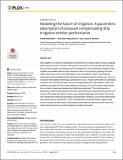| dc.contributor.author | Shamshery, Pulkit | |
| dc.contributor.author | Wang, Ruoqian | |
| dc.contributor.author | Tran, Davis V. | |
| dc.contributor.author | Winter, Amos G. | |
| dc.date.accessioned | 2017-06-20T13:35:28Z | |
| dc.date.available | 2017-06-20T13:35:28Z | |
| dc.date.issued | 2017-04 | |
| dc.date.submitted | 2016-09 | |
| dc.identifier.issn | 1932-6203 | |
| dc.identifier.uri | http://hdl.handle.net/1721.1/110038 | |
| dc.description.abstract | Drip irrigation is a means of distributing the exact amount of water a plant needs by dripping water directly onto the root zone. It can produce up to 90% more crops than rain-fed irrigation, and reduce water consumption by 70% compared to conventional flood irrigation. Drip irrigation may enable millions of poor farmers to rise out of poverty by growing more and higher value crops, while not contributing to overconsumption of water. Achieving this impact will require broadening the engineering knowledge required to design new, low-cost, low-power drip irrigation technology, particularly for poor, off-grid communities in developing countries. For more than 50 years, pressure compensating (PC) drip emitters—which can maintain a constant flow rate under variations in pressure, to ensure uniform water distribution on a field—have been designed and optimized empirically. This study presents a parametric model that describes the fluid and solid mechanics that govern the behavior of a common PC emitter architecture, which uses a flexible diaphragm to limit flow. The model was validated by testing nine prototypes with geometric variations, all of which matched predicted performance to within R² = 0.85. This parametric model will enable irrigation engineers to design new drip emitters with attributes that improve performance and lower cost, which will promote the use of drip irrigation throughout the world. | en_US |
| dc.language.iso | en_US | |
| dc.publisher | Public Library of Science | en_US |
| dc.relation.isversionof | http://dx.doi.org/10.1371/journal.pone.0175241 | en_US |
| dc.rights | Creative Commons Attribution 4.0 International License | en_US |
| dc.rights.uri | http://creativecommons.org/licenses/by/4.0/ | en_US |
| dc.source | PLoS | en_US |
| dc.title | Modeling the future of irrigation: A parametric description of pressure compensating drip irrigation emitter performance | en_US |
| dc.type | Article | en_US |
| dc.identifier.citation | Shamshery, Pulkit; Wang, Ruo-Qian; Tran, Davis V. and Winter V, Amos G. “Modeling the Future of Irrigation: A Parametric Description of Pressure Compensating Drip Irrigation Emitter Performance.” Edited by Alberto Aliseda. PLOS ONE 12, no. 4 (April 2017): e0175241 © 2017 Shamshery et al | en_US |
| dc.contributor.department | Massachusetts Institute of Technology. Global Engineering and Research Laboratory | en_US |
| dc.contributor.department | Massachusetts Institute of Technology. Department of Mechanical Engineering | en_US |
| dc.contributor.mitauthor | Shamshery, Pulkit | |
| dc.contributor.mitauthor | Wang, Ruoqian | |
| dc.contributor.mitauthor | Tran, Davis V. | |
| dc.contributor.mitauthor | Winter, Amos G. | |
| dc.relation.journal | PLoS ONE | en_US |
| dc.eprint.version | Final published version | en_US |
| dc.type.uri | http://purl.org/eprint/type/JournalArticle | en_US |
| eprint.status | http://purl.org/eprint/status/PeerReviewed | en_US |
| dspace.orderedauthors | Shamshery, Pulkit; Wang, Ruo-Qian; Tran, Davis V.; Winter V, Amos G. | en_US |
| dspace.embargo.terms | N | en_US |
| dc.identifier.orcid | https://orcid.org/0000-0003-1944-5977 | |
| dc.identifier.orcid | https://orcid.org/0000-0002-4151-0889 | |
| mit.license | PUBLISHER_CC | en_US |
| mit.metadata.status | Complete | |
